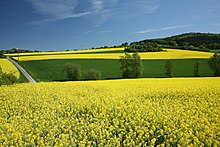Agricultural energy
As agro-energy is energy referred to by means of agriculture can be won. The narrower definition only includes agricultural bioenergies that are based on the production and use of plants or biomass . The broader definition also includes, for example, wind and solar energy generated in the area of agricultural land. In addition, critics of the current form of energetic use of renewable raw materials sometimes use the term agricultural energy in order to avoid the positive association of “bioenergy” with “environmentally friendly, ecological”.
In order to make the difference to the classic activity ( arable farming , processing ) clear, farmers who generate agricultural energy are also referred to as energy farmers .
Forms of agricultural energy
Bioenergy
see main article bioenergy
The basis of bioenergy is solar energy . This is used by plants with the help of photosynthesis to generate biomass. Depending on the type of biomass, there are different possible uses. As agricultural input materials for biomass heating plants and biomass heating power plants for heat and power generation, wood from short rotation plantations and by-products such as straw come into question. Biogas is obtained by fermenting liquid manure , plant silage and other biomass and is used to generate electricity and heat and as a raw material for biomethane as a substitute for natural gas .
In addition to the cultivation of maize for biogas production, the provision of raw materials for the production of biofuels plays the largest role in agricultural energy. Thus bioethanol by the fermentation of sugars (from sugar beet , sugar cane ) and sugar polymers such as starch (from corn , cereals , potato ) recovered. For the production of bioethanol from cellulose ( cellulose-ethanol ), wood from short rotation plantations could also play a role in the future. Vegetable oil fuels and biodiesel are obtained from oil-containing plant components (fruit of rapeseed , soy , oil palm ). Synthetic biofuels ( BtL fuels, biomass to liquid), on the other hand, can be produced from almost any type of biomass ( straw , miscanthus , short rotation wood ), but are still in development.
Other renewable energies
An expanded definition of agricultural energy also includes renewable energies that are not based on photosynthesis:
- Wind energy is often used by wind turbines on agricultural land. Since more than a third of the area in Germany is used for agriculture and high-yield wind locations are also preferred in these areas, electricity generation is important for agriculture. Because of the high investment costs, farmers usually only act as landlords or part investors in the wind farms .
- Photovoltaic systems are often installed in the agricultural sector. The roof surfaces of farm buildings offer a lot of space for the installation of the systems. In addition, agricultural land is also used by investors for the construction of free-standing systems (open-space systems).
Advantages and disadvantages
Agricultural energy offers an additional source of income for agriculture. Just like the use of bioenergy as a whole, agricultural energy offers the possibility of generating energy from regenerative raw materials, the use of which only releases as much carbon dioxide as was bound in the biomass during the growth of the plants used. Nonetheless, agricultural energy has come under fire from time to time because it competes for land with food and feed production and is said to have been partly responsible for the enormous rise in food prices in 2007 (see FAO Food Price Index ). The change in the landscape due to changes in the area of arable crops and an increase in the number and size of wind turbines is also criticized.
Individual evidence
- ↑ NABU warns: More and more grassland is being maize. NABU Lower Saxony, March 28, 2008, accessed January 18, 2016 .
- ↑ Rettet den Regenwald eV: 53 organizations demand: Don't burn food! 07-08-03 ( page no longer available , search in web archives ) Info: The link was automatically marked as defective. Please check the link according to the instructions and then remove this notice.
literature
- Fachagentur Nachwachsende Rohstoffe e. V. (FNR): Guide to Bioenergy - Planning, Operation and Profitability of Bioenergy Plants , ISBN 3-00-015389-6 . Free 354-page brochure from the FNR.
- Chamber of Agriculture Lower Saxony / 3N Competence Center Lower Saxony Network for renewable raw materials: Renewable raw materials - cultivation instructions for energetic and material utilization , Oldenburg (2008), 76-page brochure with detailed information (cultivation instructions, test results) on numerous energetically and materially usable plants
- GRAIN and Rettet den Regenwald eV: Special edition agricultural energy - Stop the agricultural energy craze , 68-page brochure. Comparison of the situations in different countries and of different crops for the generation of agricultural energy. Downloadable as PDF (1.6 MB) .
- Lambertus Verlag: Volle tanks, empty plates - The price for agro-fuels: Hunger, displacement, environmental destruction , ISBN 3784117910 . By Wolfgang Hees, Oliver Müller and Matthias Schüth, 2007



